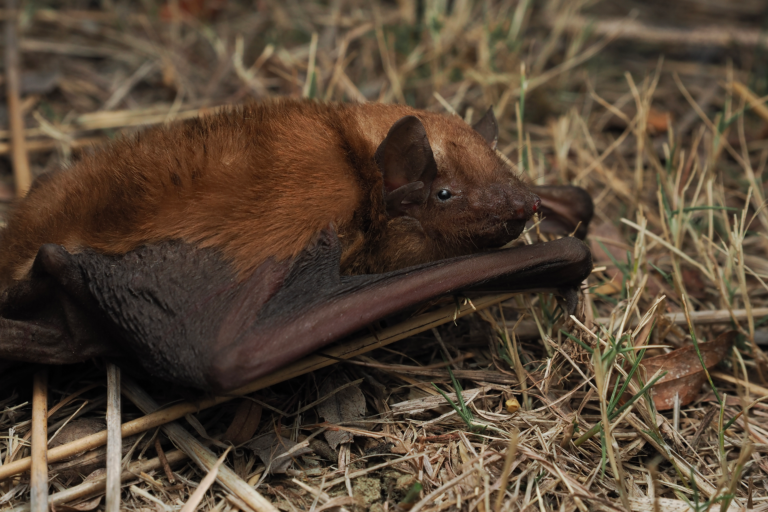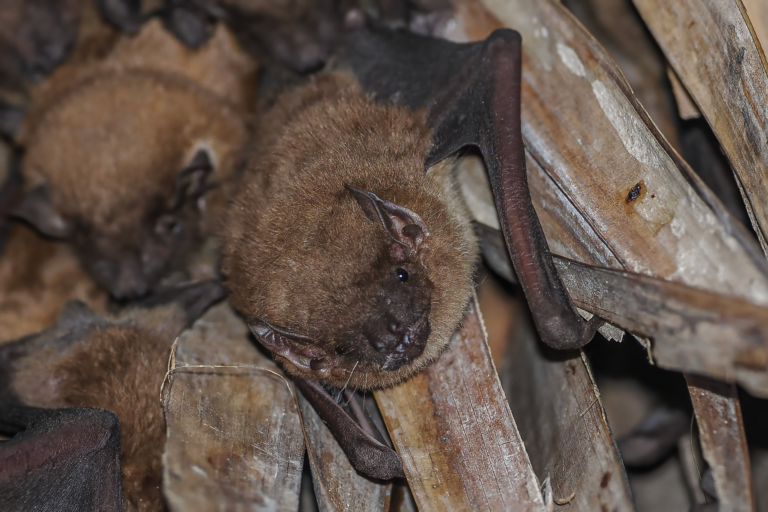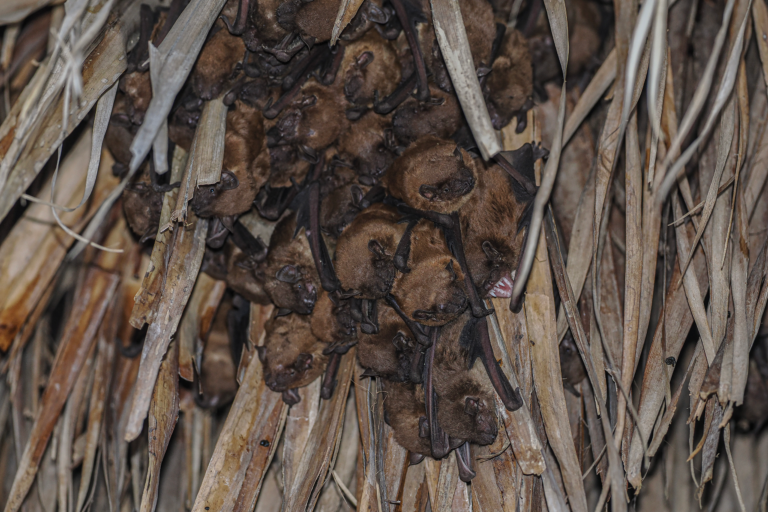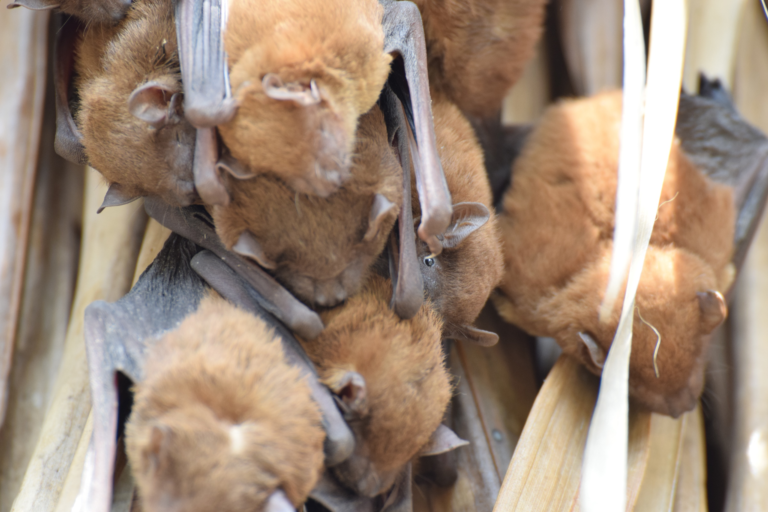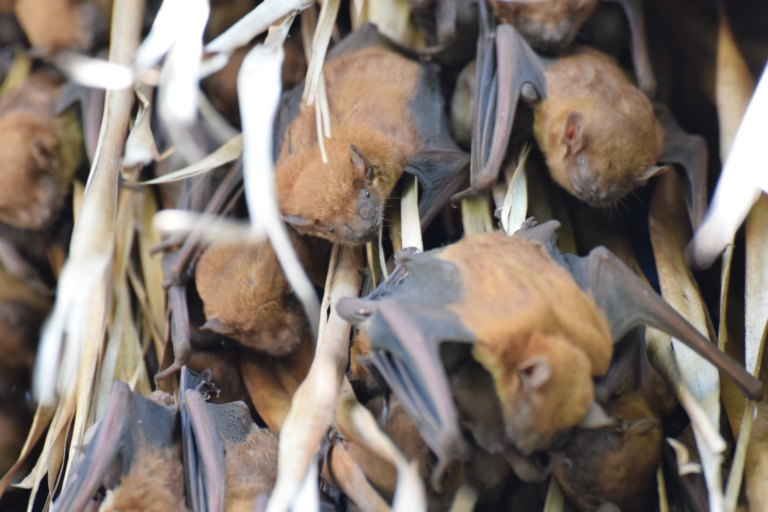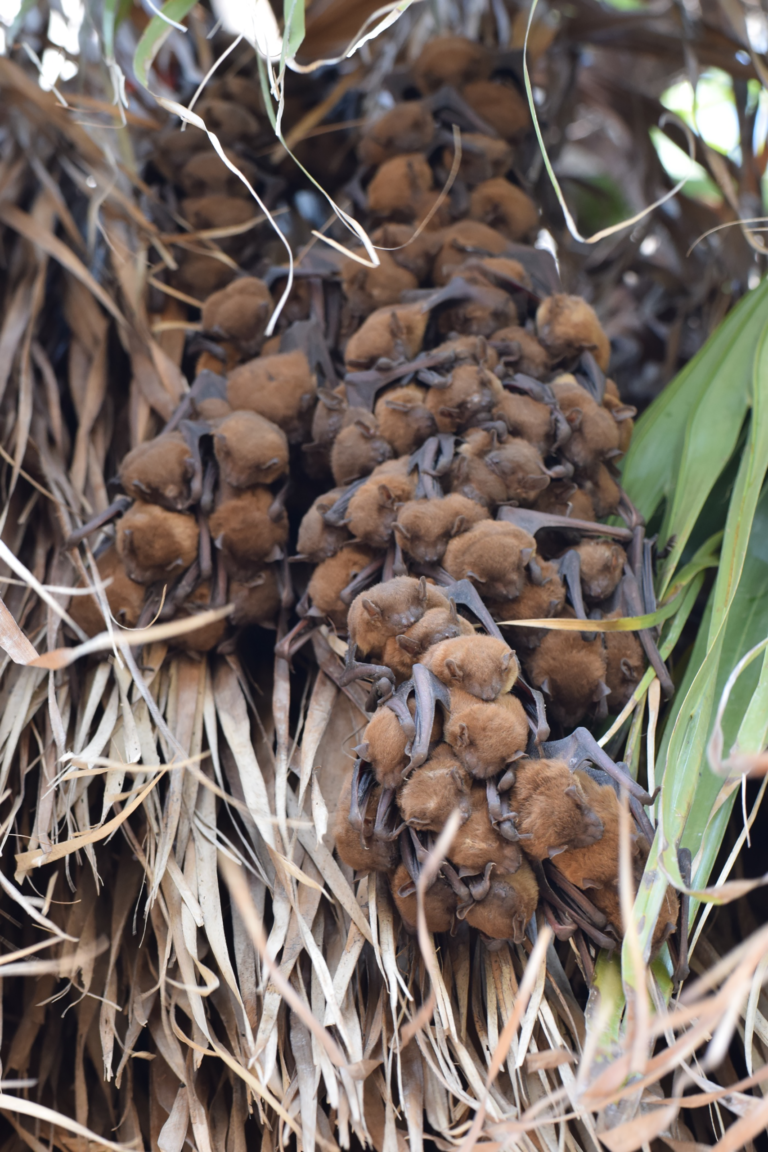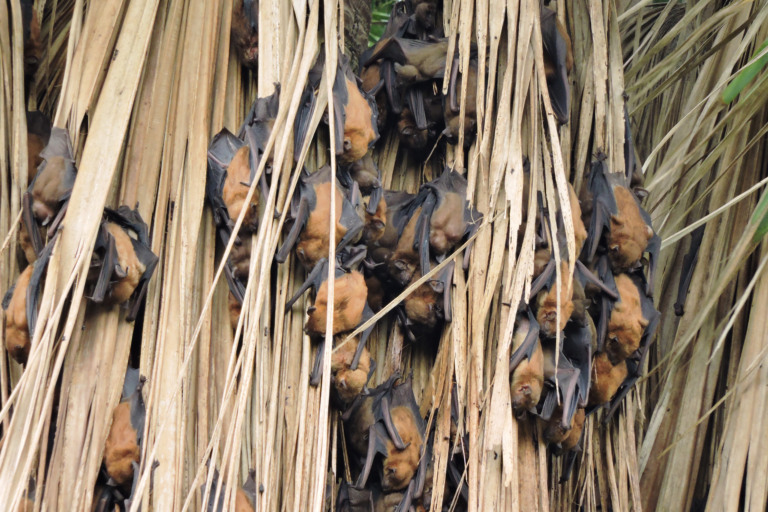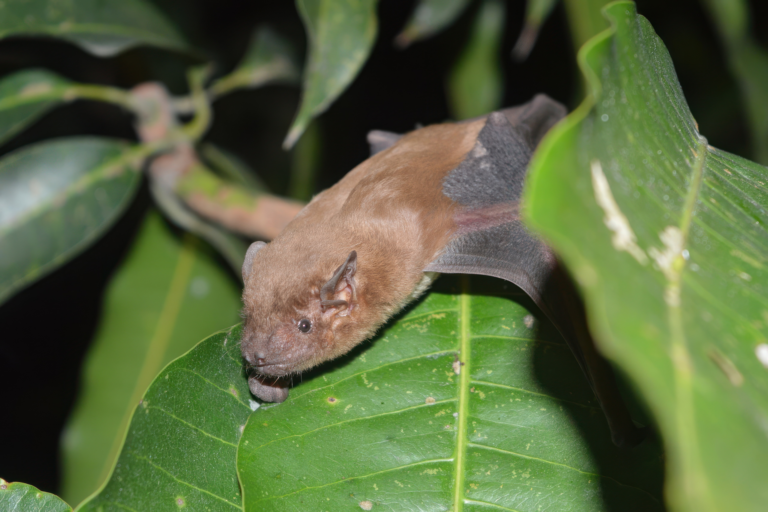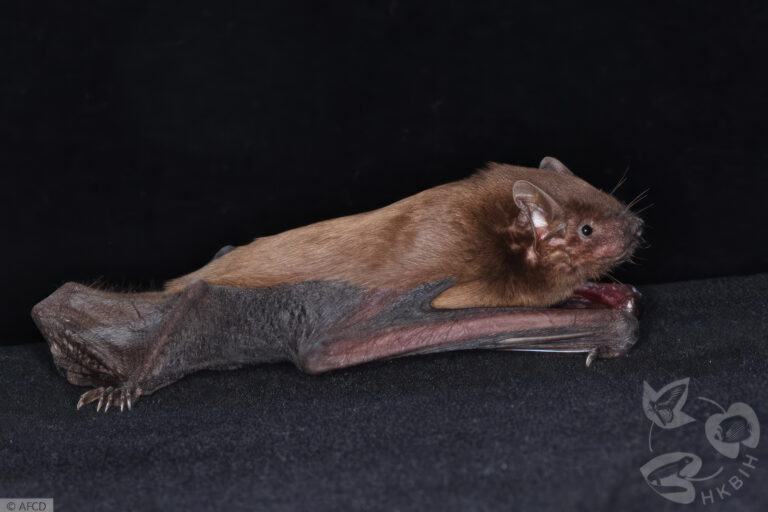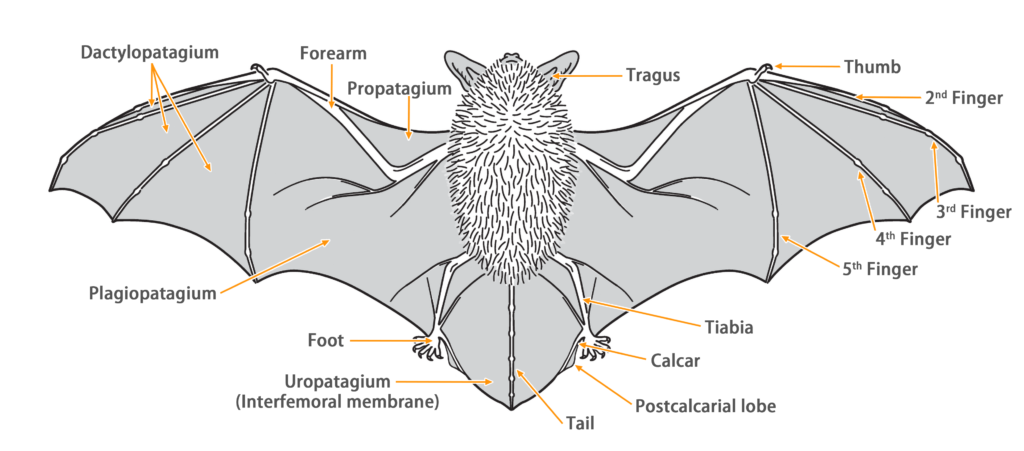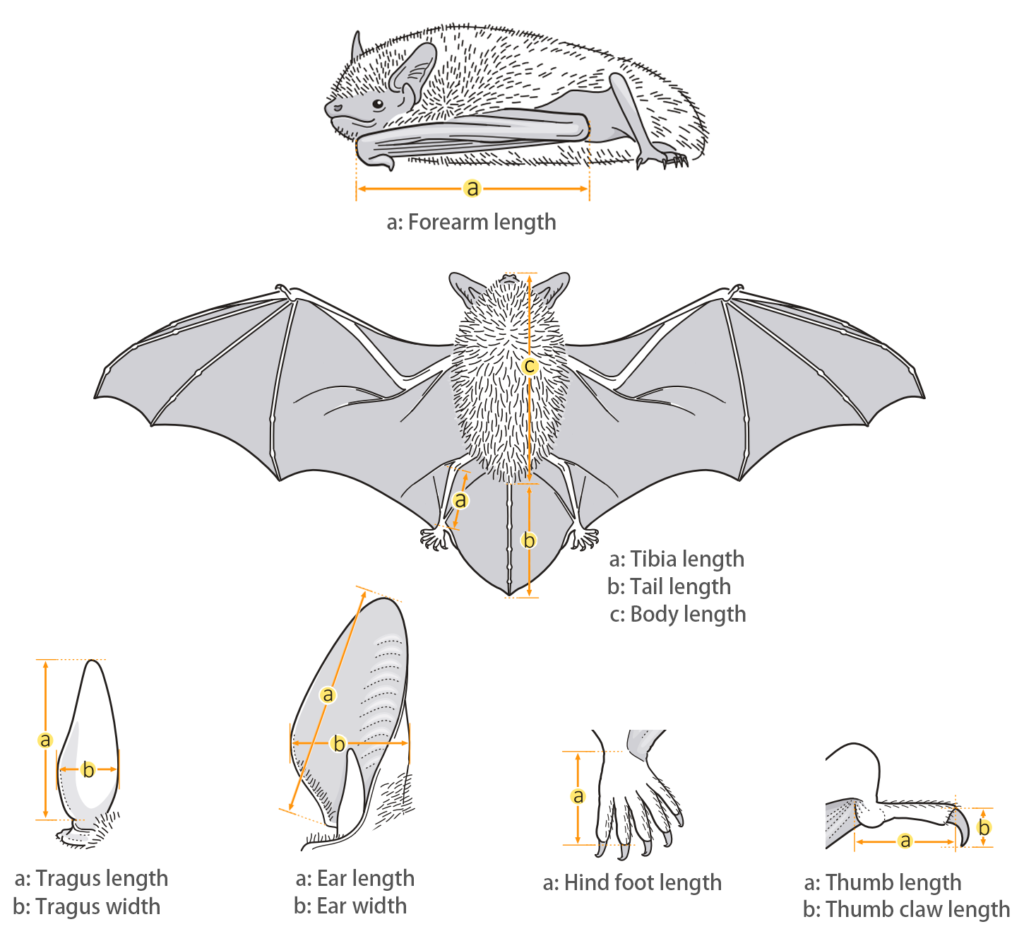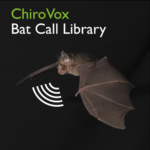- Hong Kong Bat Radar
- Lesser Yellow Bat (Scotophilus kuhlii)
Lesser Yellow Bat
Scotophilus kuhlii Leach, 1822
Taxonomy
| Family: | Vespertilionidae |
| Genus: | Scotophilus |
| Scientific name: | Scotophilus kuhlii Leach, 1822 |
| Synonyms: | Scotophilus wroughtoni Thomas, 1897 |
| Common name: | Lesser Yellow Bat |
| Other name: | Lesser Asiatic/Asian Yellow Bats, Lesser Asiatic/Asian Yellow House Bat |
| Remark: | S. kuhlii was initially considered as a subspecies of S. heathii but was later elevated to the status of an independent species including 7 known subspecies: S. k. kuhlii Leach, 1821, S. k. castaneus Horsfield, 1851, S. k. consobrinus Allen, 1906, S. k. gairdneri Kloss, 1917, S. k. panayensis Sody, 1928, S. k. solutatus Sody, 1936 and S. k. temminckii Horsfield, 1824. |
| Characteristics | |
| Color: | Pelage coloration is relatively variable and glossy. The dorsal fur varies from brown to dark brown (light brown at the base and dark brown at the tip); the ventral fur is relatively lighter. Juveniles generally have darker overall fur coloration. |
| Ear: | Eat pinna is small and oval-shaped; the tragus is long (approximately half the length of the pinna), elongated and sickle-shaped, curving forward and extending beyond the anterior margin of the pinna, with a rounded tip; pinna and tragus uniformly deep brown in color; antitragus well-developed and separated from the posterior margin of the pinna by distinct notch. |
| Head: | Posterior region of the skull swollen; the muzzle is broad and nearly hairless; laterally protruding glandular swellings; nostrils slightly protuberant. |
| Limbs: | The base of the thumb and the feet have dark brown pads. |
| Wings: | Wing membrane attaches at base of toes. |
| Tail: | Tail is long, slightly protruding from the interfemoral membrane (2-3mm). The calcar is long (~8 mm) and over halfway to tail from ankle, without postcalcarial lobe. |
| Body measurements | |
| Size: | Medium yellow bat |
| Body: | 54.8 - 82.1 mm |
| Tail: | 31.3 - 65.0 mm |
| Ears: | 7.4 - 17.0 mm |
| Hind foot: | 8.0 - 13.8 mm |
| Forearm: | 44.0 - 56.4 mm |
| Weight: | 12.5 - 30.3 g |
| Wing morphology | |
| Wing span: | 0.343 m |
| Wing area: | 0.014 m2 |
| Wing loading: | 14.9 ± 0.79 N/m2 (High) |
| Aspect ratio: | 8.53 ± 0.63 (High) |
| Tip-shape index: | 1.17 ± 0.19 (Low) |
| Reference: | Jeyapraba et al., 2023 |
Ecology
| Habitat: | They are a highly adaptable species that can inhabit various environments, including woodland, suburban areas, and urban areas. They commonly roost in crevices of buildings (rooftops, wall gaps, eaves, etc.), among the dead leaves of palm trees (such as Livistona chinensis, Washingtonia robustaroyal, and W. filifera), in tent-roost made from leaf of Livistona rotundifolia, and beneath the leaves of coconut trees. They can also roost in caves, hollow trees, tree cavities, abandoned swallow nests, and bat boxes. |
| Habit: | They are highly gregarious bat species with the size of the colonies varying depending on the available roosting space and the season. Smaller groups or solitary individuals typically roost in narrow crevices, eaves, or bat boxes, while larger colonies tend to select larger roosting sites such as rooftops, clusters of dead leaves in fan palm trees, or beneath the leaves of coconut trees. Colony sizes can range from a few individuals to thousands. In Guangzhou city, a colony of 248 bats was recorded roosting among the dead leaves of Chinese Fan-palm (Livistona chinensis ). In Chiayi County, Taiwan (Sigu), a colony of over a thousand bats was roosting among the dead leaves of a Washington palm (Washingtonia filifera ) . It is also documented that S. kuhlii roosted in tent-roosts made from the leaves of Livistona rotundifolia in the Philippines. |
| Reproduction: | Females are seasonally monoestrous that they typically mate in February to March and undergo a gestation period of about 112 days, giving birth in late May. They may have different breeding patterns in different habitats. In agricultural habitats, females were found pregnant in April to May, while in suburban areas, the pregnancy period occurs from March to April. In forest, the pregnancy period ranges from July to November. In Hong Kong and the Guangdong Province, birth is occurring around late-May to mid-June. A female gave birth to two pups once each year. After birth, the pups attached closely to the mother's abdomen for nursing. After approximately three weeks, they start to separate from the mother and roost independently within the nest. They become capable of independent flight around day 39. |
| Hibernation: | They are known to enter a state of torpor or hibernation during the cold winter months. However, there are no documented records of their hibernation in Hong Kong. |
| Flight: | They have fast flight speed and excellent flight efficiency. However, it lacks agility and has relatively poor hovering capabilities. It has a high wing-beat frequency and typically flies in a straight and stable manner. Its turning radius is larger compared to more maneuverable bat species. Their flight height ranges from 3 - 12 m. They are often observed flying in open spaces above tree canopy and along the edges of cluttered environments. |
| Migration: | They have high aspect ratio and wing loading, which contribute to its excellent flight efficiency and long-distance migratory capabilities. Their migratory behavior varies across different regions. For example, colonies in Hainan Province tend to stay during the summer and autumn seasons, migrating to other locations for overwintering around mid-November. In Guangdong Province, colonies typically stay from April to September and migrate to other areas from October to March of the following year. |
| Foraging: | They typically leave thier roosting sites after sunset. They are used to flying and foraging extensively in open environments such as grasslands, agricultural fields, fish ponds, wetlands, and above the canopy. They engage in wide-ranging aerial maneuvers, occasionally foraging near streetlights and sports field floodlights. |
| Diet: | As an insectivorous bat species with a broad and seasonal diet. They primarily hunt for prey in mid-air. Due to their fast flight speed and limited agility, they cannot rely on the sweeping or netting technique used by other bat species to catch a large number of small insects from the orders Diptera and Lepidoptera. Instead, they prefer to target larger insects from orders such as Coleoptera, Hemiptera, Lepidoptera, and Orthoptera, which provide higher energy content. |
Diet composition of S. kuhlii in China (Guangdong) (Ng et al., 2005)
Diet composition of S. kuhlii in China (Hainan) (Zhu et al., 2012)
Summer diet composition of S. kuhlii in India (Bhartiy & Elangovan, 2021)
Autumn diet composition of S. kuhlii in India (Bhartiy & Elangovan, 2021)
Winter diet composition of S. kuhlii in India (Bhartiy & Elangovan, 2021)
Distribution
| Local: | The New Territory, Hong Kong Island and Lantau Island |
| Global: | Northeast & Southeast Pakistan, India, Sri Lanka, Southeast Nepal, Bangladesh, Myanmar, South Central & Southeast China (Yunnan, Guangxi, Guangdong, Hong Kong, and Fujian) including Hainan, Taiwan, and Pescadores Islands, Thailand, Laos, Vietham (including Cat Ba Island), Cambodia, Peninsular Malaysia, Sumatra, Java, Bali, Sulawesi, and Philippines. (Don & Russell, 2019) |
Local distribution map
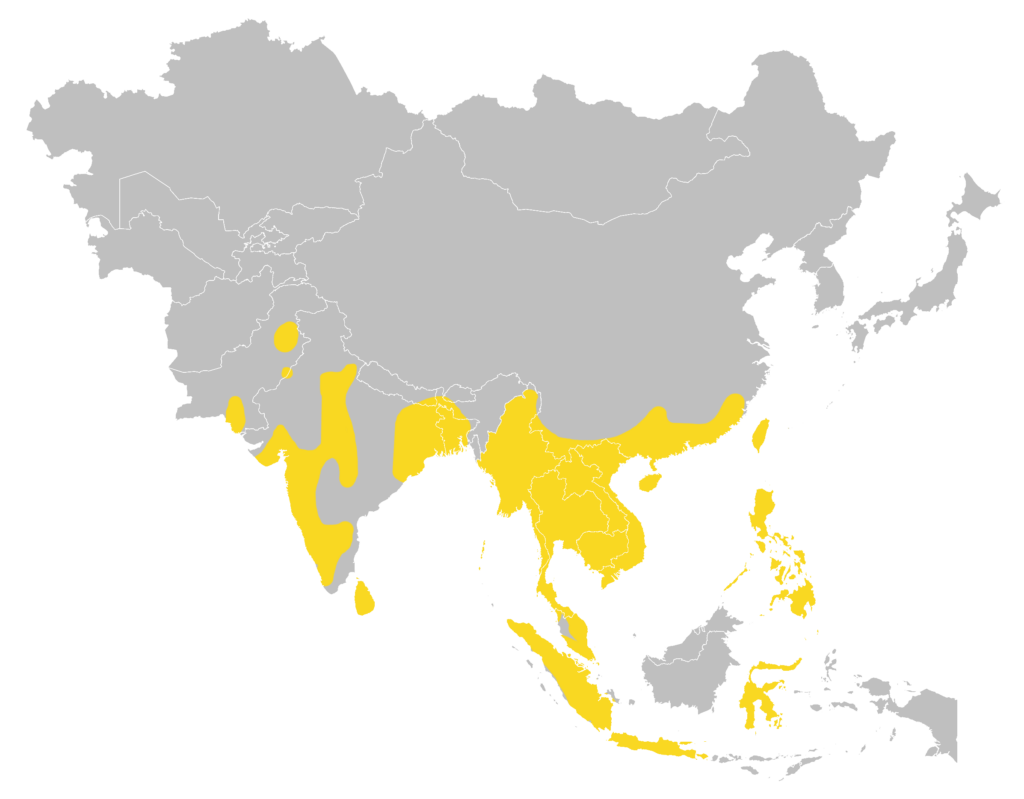
Global distribution map (Don & Russell, 2019)
Status and Conservation
| First record: | 1968 |
| Origin: | Native |
| Local status: | Uncommon (Shek & Chan, 2006) |
| National status: | Least Concern (Red List of China Vertebrates) |
| Global status: | Least Concern (IUCN Red List) |
| Potential threat: | TBC |
Echolocation
| Parameter | Value |
|---|---|
| Call structure | FM-QCF |
| Duration | 5.10 ± 1.00 ms |
| Inter pulse interval | 46.80 ± 24.70 ms |
| Peak frequency | 45.70 ± 2.10 kHz |
| Start frequency | 88.70 ± 6.90 kHz |
| End frequency | 37.90 ± 2.80 kHz |
|
Region: |
China (Hainan) |
| Method: | Hand release |
| Reference: | Zhu et al., 2012 |
| Parameter | Value |
|---|---|
| Call structure | FM-QCF |
| Duration | 4.19 ± 2.00 ms |
| Inter pulse interval | - ms |
| Peak frequency | - kHz |
| Start frequency | 65.62 ± 12.42 kHz |
| End frequency | 41.04 ± 2.27 kHz |
|
Region: |
Taiwan |
| Method: | Hand release |
| Reference: | Chou & Cheng, 2012 |
Bibliography
Bhartiy, S. K., & Elangovan, V. (2020). Reproductive behaviour of Asiatic lesser yellow bat, Scotophilus kuhlii (Chiroptera: Vespertilionidae) in Uttar Pradeh, India. Journal of Experimental Zoology India, 23(2), 1577-1585.
Bhartiy, S. K., & Elangovan, V. (2021). Seasonal prey availability and diet composition of Lesser Asiatic Yellow House Bat Scotophilus kuhlii Leach, 1821. Journal of Threatened Taxa, 13(8), 19002-19010.
Chen, S. F., Huang, S. S., Lu, D. J., & Shen, T. J. (2015). Postnatal growth and age estimation in Scotophilus kuhlii. Zoo Biology, 35(1), 35–41.
Cheng, H. C., Fang, Y. P., & Chou, C. H. (2022). A Photographic Guide to the Bats of Taiwan (4th ed.). Taiwan Endemic Species Research Institute.
Chou, C. H., & Cheng, H. C. (2012). Echolocation Calls of the Eleven Insectivorous Bats of Taiwan. Taiwan Journal of Biodiversity, 14(34), 33-62.
Jeyapraba, L., Margaret, I. V., Addline, D., & Sakthi, V. (2023). Prediction of foraging strategy of insectivorous bats through their wing morphology. Journal of Survey in Fisheries Sciences, 10(3S), 1,903-1,917.
Jiang, Z. G., Jiang, J. P., Wang, Y. Z., Zhang, E., Zhang, Y. Y., Li, L. L., Xie, F., Cai, B., Cao, L., Zheng, G. M., Dong, L., Zhang, Z. W., Ding, P., Luo, Z. H., Ding, C. Q., Ma, Z. J., Tang, S. H., Cao, W. X., Li, C. W., Hu, H. J., Ma, Y., Wu, Y., Wang, Y. X., Zhou, K. Y., Liu, S. Y., Chen, Y. Y., Li, J. T., Feng, Z. J., Wang, Y., Wang, B., Li, C., Song, X. L., Cai, L., Zang, C. X., Zeng, Y., Meng, Z. B., Fang, H. X., & Ping, X. G. (2016). Red List of China’s Vertebrates. Biodiversity Science 24(5), 500‑551.
Li, Y. C., Chen, Z., Long, Y. R., Zhou, F., & Zhong, Y. R. (2006). Species Diversity of Chiroptera in Ma’anling Volcano Area, Hainan Island. Chinese Journal of Zoology, 41(3), 106-109.
Liu, S. Y., Wu, Y., & Li, S. (2022). Handbook of the mammals of China (3rd ed.). The Straits Publishing & Distribution Group.
Moratelli, R., Burgin, C., Cláudio, V., Novaes, R., López-Baucells, A., & Haslauer, R. (2019). Vespertilionidae. In Mittermeier, R. A., & Wilson, D. E. (Eds.), Handbook of the Mammals of the World – Volume 9 Bats. (pp. 716-981). Lynx Edicions.
Ng, Y., Ting, J., & Zubaid, A. (2017). Man-made maternity roost selection by Scotophilus kuhlii (Lesser Asiatic yellow bat) in two anthropogenically altered habitats. Malayan Nature Journal, 69(1), 31-39.
Rickart, E. A., Heideman, P. D., & Utzurrum, R. C. (1989). Tent-roosting by Scotophilus kuhlii (Chiroptera: Vespertilionidae) in the Philippines. Journal of Tropical Ecology, 5(4), 433-436.
Shek, C. T. (2006). A Field Guide to the Terrestrial mammals of Hong Kong. Friends of country park and cosmos book limited.
Tong, C. P. (2016). Distribution and preference of landscape features and foraging sites of insectivorous bats in Hong Kong urban parks. HKU Theses Online (HKUTO).
Zhu, G., Chmura, A., & Zhang, L. (2012). Morphology, echolocation calls and diet of Scotophilus kuhlii (Chiroptera: Vespertilionidae) on Hainan Island, south China. Acta Chiropterologica, 14(1), 175-181.
吳毅、余文華、李小琼(2005年9月26日)。小黃蝠(Scotophilus kuhlii )生態的初步研究。第二屆全國野生動物生態與資源保護學術討論會,黑龍江省哈爾濱,中國。(In Chinese only)
祁偉廉(2008)。台灣哺乳動物(第一版)。天下文化。(In Chinese only)
Hong Kong Bat Radar. (18/05/2025). A Field Guide to Bats of Hong Kong: Lesser Yellow Bat (Scotophilus kuhlii ). https://hkbatradar.com/en/scotophilus_kuhlii
